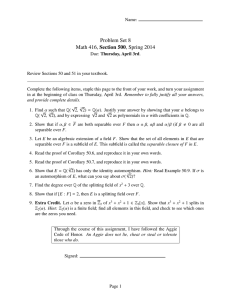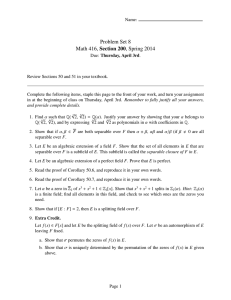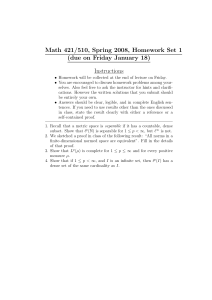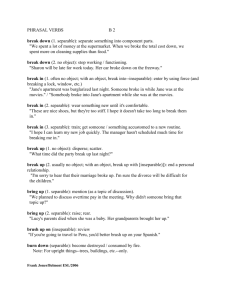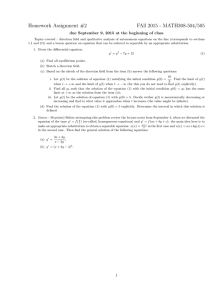Additively Separable Representations on Non-convex
advertisement
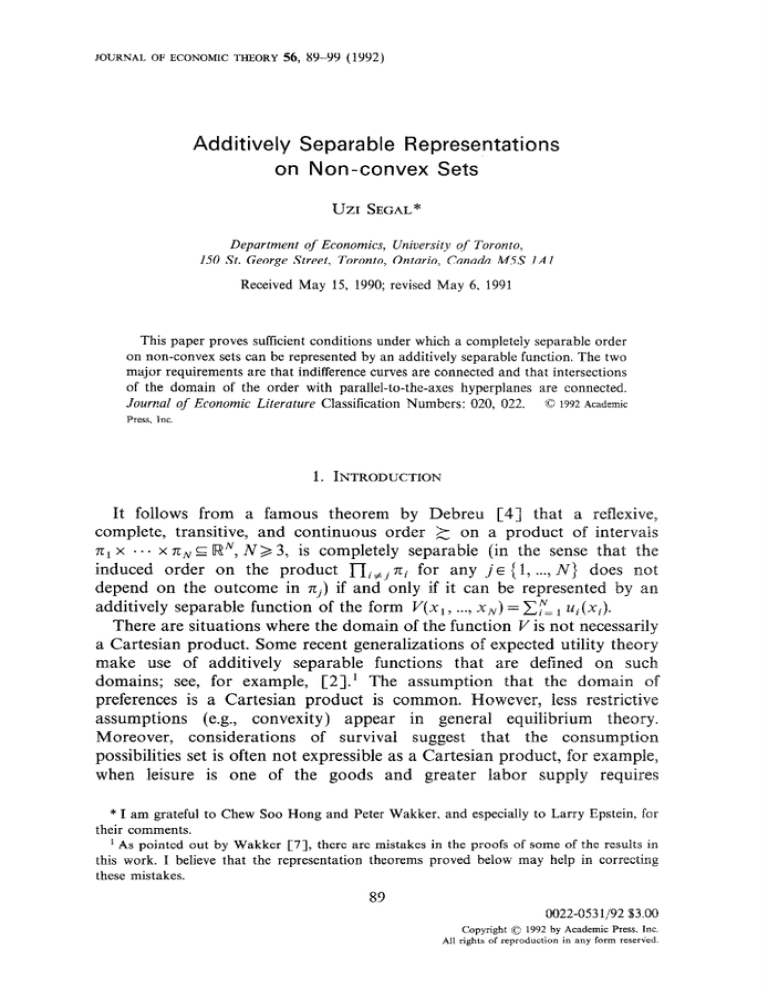
JOURNAL
OF ECONOMIC
56, 89-99
THEORY
Additively
(1992)
Separable Representations
on Non-convex
UZI SEGAL*
Department
150 St. George
of Economics,
Street, Toronto,
University
Ontario,
qf Toronto,
Canada M5S
IA1
Received May 15, 1990; revised May 6. 1991
This paper proves sufficient conditions under which a completely separable order
on non-convex sets can be represented by an additively separable function. The two
major requirements are that indifference curves are connected and that intersections
of the domain of the order with parallel-to-the-axes hyperplanes are connected.
Jourrzal of Economic
Literature
Classification Numbers: 020, 022. c 1992 Academic
?ress. Inc.
1. INTRODUCTION
It follows from a famous theorem by Debreu [4] that a reflexive,
complete, transitive, and continuous order 2 on a product of intervals
rrl x ... x xN c RN, N> 3, is completely separable (in the sense that the
induced order on the product njzini
for any Jo (I, ...) Nj does not
depend on the outcome in 711)if and only if it can be represented by an
additively separable function of the form V(x,) .... x,) = Cy= 1 ui(xl).
There are situations where the domain of the function V is not necessarily
a Cartesian product. Some recent generalizations of expected utility theory
make use of additively separable functions that are defined on such
domains; see, for example, [2].’ The assumption that the domain of
preferences is a Cartesian product is common. However, less restrictive
assumptions (e.g., convexity) appear in general equ.ilibrium
theory.
Moreover,
considerations
of survival suggest that the consumption
possibilities set is often not expressible as a Cartesian product, for example,
when leisure is one of the goods and greater labor supply requires
* I am grateful to Chew Soo Hong and Peter Wakker. and especially to Larry Epstein, for
their comments.
‘ As pointed out by Wakker [7], there are mistakes in the proofs of some of the results in
this work. I believe that the representation theorems proved below may help in correcting
these mistakes.
89
00224X31/92
$3.00
Copyright
Q 1992 by Academic Press. Inc.
All rights of reproduction
in any form reserxkd.
90
UZI
SEGAL
increased nourishment. (See Blackorby, Primont, and Russell [ 1 ] for a
survey of applications of additively separable functions in economics.)
Debreti’s theorem was recently extended by Wakker [6] to ordered
cones (i.e., sets in [WN,where x1 2 ... 3 xN > 0). In Theorem 1 below I add
a monotonicity assumption and prove this theorem for more general nonconvex sets. The crucial conditions concerning the domain of the order 2
are that all its indifference surfaces are connected sets (see [7] for the
importance of this condition) and that the intersection of this domain with
any parallel-to-the-axes hyperplane is a connected set. Section 2 deals with
the case of an open domain, and Section 3 proves a sufficient condition for
the existence of an additively separable representation on a closed set given
that such a representation exists on its interior. Section 4 concludes with
three examples illustrating
the importance of some of the assumptions
used throughout.
Topological
definitions and claims are taken from
Dugundji [ 5 1.
2.
OPEN
DOMAIN
Let the connected [S, p. 1071 and open subset SC IW”‘, N> 3,2 satisfy the
condition that for every i and c, the set S(i, c) = Sn {(xi, .... xN) : xi= c} is
a connected subset of RN. Of course, the connectedness of S does not
imply, nor is it implied, by the connectedness of the sets S(i, c), as is
demonstrated
by the sets S=(0,3)3\([1,3)x(0,3)x[1,2])
and S=
(0, 1)3 u (2, 3)3.
Let k be a reflexive, complete, and transitive order on S. For x, y E S,
define x- y if and only if x z y and y 2 x, and x> y if and only if
xky
but not ykx.
The order 2 is called strictly monotonic
if [V’~E (1, .... N}yi>,xi
and 3i~{l,...,N}
such that yi>x,]*y=
xN).
It
is
called
continuous
if for every XE S the
(Y 1, .... YN) > x = (Xl, ...>
two sets {y~S:y>x}
and (y~S:x>y}
are open in S. Assume
throughout that 2 is strictly monotonic and continuous. For every x E S,
let Z(x) = {y E S : y-x}
be the indifference surface of 2 through x.
Assume further that all indifference surfaces of k are connected subsets
of LW? By Debreu [3] there exists a continuous function I’: S --+ [w
representing the order 2, that is, x 2 y if and only if V(x) > V(y).
1. The function V: S --) [w is called completely separable if,
for every (Xl, .... Xi-l, xi, xi+l, .... XN), (YI, .... Yip1, xi, Yi+l, .... yN),
(x 1, +-, xi- 1, Y:, Xi+ 1, -, x,), and (~1, --., Yi- 1, Yi, yi+ 1, .... YN) in S,
DEFINITION
V(x 19
*
’ When
v(x13...,
“‘3
xi&l,
xi9
xi+l,
xi-l,
Yi,
xi+19.-*9
N = 2, strict
monotonicity
...? xN)2
xN)3
implies
v(.Yl,
...t
v(Yl,**.,
complete
Yi-l,
Xi,
,Yj+l,
...T YN)
Yi-12
Yi,
Yi+l,
***> YN).
separability
(see Definition
1).
ADDITIVELYSEPARABLEREPRESENTATIONS
Let xi(S) be the projection
ni(S)=
91
of 5’ on the ith axis,
(Xi: 3(X,, ...) Xj, ...) XN) E S>.
Since S is an open connected subset of RN, xi(S) is an open interval,
i=l , .... N.
DEFINITION 2. The function Y: S + R is called additively separable if
there exist continuous and strictly increasing functions ui: ~~(5’) --f R, i =
1, ...7N and a strictly increasing function i: Rng(Cy= 1 ui(. )) -+ R! such t
V(x 1,
where Rng(Cy=,
cf+l 1 %(Xi) 1.
THEOREM
I.
ui(.))
...> xN)=i
($:
ui(xil)3
= {x E R : 3(x,, .... xN) E RN
such
that
x =
Let N 3 3 and let (S, 2) satisfv the following conditions:
e The set S is an open and connected subset of IWN
c For every i and c, the set S(i, c) is a connected subset of IWN
0 The order 2 on S is continuous and strictly monotonic
9 All indifference surfaces of ,> are connected subsetsof WN.
Then a representation function V of 2 is completely separable if and only if
it is additively separable.
Obviously, if V is additively separable, then it is completely separable.
The proof that the opposite is also true follows from Lemmas 14. In
sequel, the term open box means a set of the form ny= 1 Ji, where bj
nonempty bounded open interval in zi(S), i = 1, .... N. For each x0 E S, let
R(x’) be an open box in S containing x’.~ By Debreu’s f4] theorem, there
are strictly increasing and continuous functions uj( .; x0) and i( .; x0) such
that on R(xO),
vxt >.... x,)=(
5 uj(xi;xo);xo
( i=t
)
.
(1)
LEMMA 1. Let x0 = (xy, .... xt, ...>x”,), y” = (yy, .... x&, .... y”,) E S and let
R” and RY be two open boxes in S such that X’E R” and y’~ RY. Let the
order 2 on R’ be representedby C;“_ 1uf(xi), z = x, Y.~ Then there are a > 0.
b, and E> 0, such that for every xi0 E (X:-E, xi + E), ui’,(xjO)= au;(x,) + b.
Proof
The set S(io, xt) is (isomorphic
3 There are, of course, a lot of open boxes containing
of these possible boxes to be R(x”).
4 Such representations
exist by Debreu
[4].
to) an open set in 18~~” an
Y’ in 5’. For every
x0 we choose
one
92
UZI
SEGAL
connected, hence path connected. (A set TE RN is called path connected if
for every x, y E T there exists a continuous mappingf: [0, 1] -+ T such that
f(O)=x
and f(l)= y; see [S, pp. 114-1161.) There is, therefore, a
continuous mapping f: [0, 1] + S( zO,
. xi) such that f(0) = x0 and f( 1) = y”.
Denote its image by L. The curve L c S is compact [S, p. 2241; hence there
is a finite set of open boxes R’, .... R” c S covering L. Assume, without loss
of generality, that R’ = R”, R” = RY, and Rjn Rjf 1 # @, j= 1, .... m - 1.
By the above-mentioned
theorem of Debreu, on Rj the order can be
represented by Uj(x,, .... xN) = Cy= i u{(xJ, j = 1, .... m, where of = ~7 and
u’ z UT, i= 1, .... N.
Let 16 j-cm. On the set Rjn R j+l the order can be represented by both
Uj and Uj+‘; hence there exists a positive linear transformation such that
Ui+l = ajUj + bj (see [4]). In particular, on this intersection, $’ ’ =
ajui + bj. Let (X&-E, xi + E), E> 0, be contained in the projection on the
ioth axis of the open boxes R’, .... R”. This E satisfies the conditions of the
lemma.
Q.E.D.
Remark. The proof of Lemma 1 is the only place in the proof of
Theorem 1 where the assumption concerning the connectedness of the sets
S(i, c) is used.
LEMMA
2. There are N strictly increasing and continuous functions
ui: 7ci(S) -+ R, i= 1, .... N, such that for every x0, OIZ R(x’), V(x,, .... xN) =
CCC;“=1 ui(xi);
xo).
Proof. I show first how to construct ur. Let x1 = inf n,(S) and X, =
sup rcr(S). If S is unbounded, x1 may be ---co and Xi may be co. Let
# +x1 and X; --f X, such that for every n, $+I < C&C 2x1~ 2;’ ‘. Let Y” =
[&, Xy]. For every t E Y” there is a point x(t) = (t, x2, .... xN) E S with the
open box R(x( t)) c S. Let the open interval X(t)
be the projection of
R(x(t)) on the xi(S). Since Y” is compact, there is a finite set of these open
intervals covering Y”. Denote them by X1, .... X”, and assume, without loss
of generality, that ~7 E X’, X; E X”, X’n Xj+ ’ # a, j = 1, .... m - 1, and
XjnXj+‘=@,
j= 1, .... m - 2. Otherwise, if for some j, Xj n Xj+ 2 f 0,
then {Xl, .... Xj, Xj+‘, ..,, Xm} is also a cover of Y”. Note that this implies
Xi) = @. For every 1 < j< m there is
that for k<m-1,
Xkn(U,“=,+,
tiE Xj such that Xj is the projection on nr(S) of the open box R(x(tj)). On
R(x(tj)) the order 2 can be represented by Cy=“=,ufn(xi), where the
functions z@ are strictly increasing and continuous, i = 1, .... N, j = 1, .... m.
Define u;: Y” + R as follows. For xl E Y” n X”, let ul(xl) = uT”(xr). Let
k E { 1, .... m - 1) and suppose that we have defined u; on Y” n
Xi) and redefine the functions u$~, i = 1, .... N and j = k + 1, .... m,
c&+1
such that for x1 EX~, u;(x,)= uI.II(xl), j= k+ 1, .... m. Extend u; now
to Y” n (UJ?+ Xj) as follows: Let ? E Xk n Xk+ ‘. By Lemma 1 it
ADDITIVELY
SEPARABLE
REPRESENTATIONS
93
follows that there is an open interval T around I in z,(s) on which
u;+yxJ
= &‘;.” (x1) + bk with uk > 0. Assume therefore, without
loss of generality, that on R(x(t”))
the order is represented by
ak xy= I am*
+ bk rather than by Cr’ 1 uF~(xJ, and redefine u:*, .~.,7~:”
accordingly. Hence on T, ~7” = uf+‘ln = u’;.
Suppose now that there exists xl* E XknXk+’
such that z@(x~) #
u:’ ““(x:).
Assume first that XT > Z Let t* = infix, > i : u?“(x~) +
u~“,~(x~)>. Since on T, u F” = u/;+I,~, it follows that t* > Z y Lemma 1
there is an open interval T* around t* on which ~4,~ is a positive linear
transformation
of U: + ‘.n. Since these two functions coincide on [i, f*]*
they must also coincide on T*, a contradiction. Similar proof deals with
the case XT < 7. It thus follows that on Xk n XC”+ ‘, ~7” = M’;+ ‘.n = u;.
Extend now the function UT such that on Xk, u; = u:“. For every k < nz - 1,
Xj) = 0, hence this extension of ~4 does not violate its
Xkn (i&k+2
already defined values. In a finite number of steps we obtain u; defined for
every x1 E Y”. Since for every k, u F” is strictly increasing and continuous,
so is u;.
Suppose now that another choice of points a boxes yields the function
v:~ By Lemma 1 there is a finite open cover o n such that on each of its
members, UT is a positive linear transformation of UT. Since these open sets
have nonempty open intersections, it must be the same transformation on
each neighbouring set, hence on all of these sets. The function u; is thus
unique up to positive linear transformations. That is, there are a > 0 and h
such that on Y”, v; = au; + b.
Consider now the functions u; and u;’ ‘. By the above arguments, we
may assume, without loss of generality, that on Y”, uinfl_ - ti;.
x1 E [xi, %:I, let u~(x,)=u~(x,)
and, for xi E [x;+‘, 3;)~ (27, x’;+“], let
ui(xi) = u’;’ ‘(xi). The function U, is thus defined on (xi, Xi), and since for
every n, u; is strictly increasing and continuous, so is ui.
Let x’ES. By (l), the order k on R(x’) can be represented by
C;“= 1 u,(x,; x0). I sh ow next that on its domain, ul( .; x0) is an increasing
linear transformation of ui. Let Z be the projection of R(x”) on z,(S). Let
01,/3 E 2, and let n such that [a, /?I c ($,5;).
For each z E [a, /J] there is,
by Lemma 1, an open interval around z in Z n ($, 2;) on which ui( .; 2)
is an increasing linear transformation of UT, and hence also of U! By the
same arguments used in the construction of u; it is easy to verify that
ul(.; x0) is an increasing linear transformation
of u1 on [a, /?]. Let
[P, /3”] 3 Z to get the desired result.
Repeat the above procedure for each coordinate.
arguments we have now obtained the condition for V on
vx
15 ...2 XN)
= [
;
c i=l
[ai
Ui(Xi)]
+ b(XO);
X0
,
1
(2)
UZI SEGAL
94
where b(x’) = C b,(x’). The functions ui are unique up to positive linear
transformations. Assume therefore, without loss of generality, that at a certain point x* ES, aI
= ... = a,.,,(~*) = u(x*). I now want to show that
for every x0 E S, ai
= . . . = aN(xo). Let x0 E S, and let the curve L c S
connect x* and x0 (recall that as S is open and connected, it is also path
connected). Each point x on the curve defines an open box R(x), and, since
L is compact, it can be covered by the finite set of open boxes
R(x’), ...) R(x”), where x1 =x*, xm =x0, and R(x’) n R(xj+‘) # 0, j=
m- 1. On the open set R(x*)nR(x2),
we obtain the two representa:;oz Cr=“=, [U(X*) Ui(Xi)] + b(x*) and Cfi 1 [a,(~‘) Us]
+ b(x2). By [4]
they are cardinally equivalent; that is, Cfi 1 [a;(~‘) ui(xi)] + b(x2) is a
positive linear transformation
of Cyz I [a(~*) ui(xi)] + b(x*). Hence
=
a,,,(~~).
By
finite
induction
it thus follows that ur(x”) = . . .
q(x’) = . . .
= UN(XO).
We now obtain from (2) that on each R(x’),
T/(x,,
. ..) xff)
=
5:
u(x”)
(
Define ((s; x0) = [(u(x’)s
g
i=l
Ui(Xi)
+
b(xO);
x0
.
)
+ b(x’); x0) to obtain the desired representation.
Q.E.D.
Next I prove that the above representation can be used as a global one
independent of x0. For this, only the connectedness of the indifference
surfaces is used. I start with the following technical lemma.
LEMMA 3. All indifference
surfaces
of the order k are path connected.
Proof: Let I be an indifference surface of 2, and define f: Z 4 RN- ’ by
f(x1, x2, *.*>XN) = (x2, a’.,xN). This function is clearly continuous, and,
since the order 2 is strictly monotonic, f is one to one. Let G be the range
of f, G= ((x2, .... xN) : 3x, such that (x1, x2, .... xN) E Z}. The inverse
f-l: G-+Ioffis
th ere f ore well defined. The function f-' is also continuous.
Indeed, let {(xz, .... x>)}:=~ c G such that (xi, .... XL) + (xi, .... z&,), but
suppose that (x7, x;, .... xk) =fr(xi,
.... x;)
does not converge to
...) x”,). Assume, without loss of generality, that
by, x;, .... x;, =f-‘(x;,
E >O.
It thus follows by strict monotonicity
that
Vn,x;>xy+z,
0 0 x”,, - (x7, x;, ...) x%) > (x7 + E, xi, ...) x”,) -+ (x? + E, xi, ...) x”,) >
i;p: z;-:y, x”,), a contradiction.
Next I show that the set G, the range off, is open in RN-‘. That is,
w 2, .... xN) E G there is 6 > 0 such that d((y2, .... yN), (x,, .... xN)) < 6 +
Let
(Y 2, -*-,yN) E G, where d( ., .) is the Euclidean metric on RN-‘.
and let x=(x1,x2 ,..., xN) =f-‘(x2,
.... xN). Since S is
(x 2, .... x,)EG,
ADDITIVELY
SEPARABLE
REPRESENTATIONS
95
open, there exists E> 0 such that B(x, e) c S, where B(x, E) is the ball of
radius E around X. By the strict monotonicity
of 2 it follows that
x1=cx,+-;, x2)...)
x,)tx>x’=(I,-~,x2....xN)
Since k is continuous there is 6 > 0 such that B(x’, 6) u B(x’, ii) c B(x, e)+
and for every y’ E B(x’, 6) and y2 E B(x2, 6), yi > x > y2. Eet (y2, .... yN) E
RN-’
such that d((y,, ..‘, yN), (x2, .... xN)) < 6. It follows from the
definition of 6 that (x1 +&/2, y,, .... yN), (x1 -e/2, y,, ...) y,)eS and that
(Xl + 45 Y2> ‘..> YN) > x > (Xl - $2, y,, .... yN). Hence by the continuity of
2 and the convexity of B(x, E), there exists z1 such that (zr , yz, .... yN) E S
and (zr, y,, ..i, yN)-x. Therefore, (y2, .... yN)eG.
The range of a continuous function on a connected set is connected
p. 108 ], and since G is open, it is also path connected. The function f ~ is
continuous, I= f ~ ‘(G); hence the indifference surface I is path co
[5, p. 1151.
LEMMA
4. In the notations of Lemma 2, V(x,, . ... xN) 3 Vfy, , .... yN) G
fL 1 %i%) 2cfi 1 U,(Y,).
Proof: Let V(xl, .... x,)= V(yl, .... y,); that is, the two points x=
(X 1, ..., xN) and y = (y,, .... yN) are on the same indifference surface I of 2.
Let the curve L ~1 connect these two points, and let the open boxes
R(x) = R”, ...) R” = R(y) be a finite open cover of L in S such that for every
j,LnRjnR.‘+‘f@
( recall that L is a connected set). Let zi E L n
Rj+l ) j = 1, ..,) m - 1. On each of the open boxes R’, ~.~,R” the order 2 can
be represented by W(W) = Cf’_ 1 ui(wi); hence
Suppose now that there are x = (x,, .... xN) and y = (y,, .... y,,,) SW
V(x)> V(y) (and x>y),
but Ci”=l~i(xi)~Cfil~i(yi).
Let the curve
L c S connect these two points; that is, there is a con
function f: [O, 1 ] -+ L such that f(0) = x and f( 1) = y.
may assume that for every TV (0, l), x>f(t)
> y. Otherwise, let
S=max(tE
[0, 1) :x-f(t)}
and r=min{tE(s,
I] : y-f(t)),
and replace
x by f(s) and y by f(r). By the first part of this proof, the value of the
function Cy! I ui is the same at x and f(s), and at y and f(r). Define
g, h: [0, l] + 58 by g = (Cj?! 1 ui) of and h = Vo$ Since the functions S, ‘V3
and ul, .... uN are continuous, so are g and h. Moreover, g(O) < g( 1) and
h(O)>h(l).
Let the open boxes R(x) = R’, .... R” = R(y) be a finite open cover of L
642/56/l-7
96
UZI SEGAL
in S as in the first part of this proof. On R(y) both V and Cr= i ui represent
the order 2. By construction, for every z E L n (R(y)\{ y } ), z > y; hence,
for such z, C;“= I ui(zi) > Cy! i u,(y,). There is, therefore, t E (0, 1) such that
g(t) > g( 1) > g(0); hence the continuous function g reaches a maximum A
on (0, 1). Let t*=min(tE
[0, l] : g(t)=A}.
On R(f(t*)) both V and xi”= i ui represent the order 2. There is E> 0
such that for t E (t* -F, t*), f(t) E R(f(t*)), and g(t) < g(t*), hence for t E
(t* -8, t*), f(t*)>f(t),
and h(t)<h(t*).
Since h(O)>h(t*), there exists
SE (0, t*) such that h(s) = h(t*). By the first part of this proof it follows
Q.E.D.
that g(s) = g(t*), in contradiction with the definition of t*.
Theorem
1 now follows by Lemmas l&4.
3. CLOSED DOMAIN
The results of the last section do not hold for closed sets (see [7] for
counterexamples). Following Wakker’s examples it is possible to show that
Theorem 1 does not hold even when the set S is bounded and equals the
closure of its interior. For example, let S= Conv{ (0, 0, 0), (10, l,l),
(1, 10, 11, (4 1, W), and let V(X, , x2, x3) = x1x2x3. On the interior of S,
V(xl, x2, x3) = .pxl+-+‘nx3,
but this representation cannot be extended
to S. In other words, V is completely separable, but not additively
separable.
Let SC RN be compact, and define, for i = 1, .... N,
Si={(X1,...,Xj--l,Xi,Xi+l,...,XN)ES:
(Y 1,
..*9
Yi-19
Yi3 Yi+l,
sj= ((x,, ...) Xi-l,Xi,Xi+l
(Y 19
THEOREM
***2
Yi-13
Yi,
Yi+l>
...T
YN)ES*Xi~Yi}
)...) x,)ES:
.“>
YNlESJXi6
Yi}-
2. Let N > 3 and let (S, 2, V) satisfy the following conditions:
l
The set SE RN is compact and equals the closure of its interior
l
The interior of S, denoted by T, is a connected subset of RN
The order 2 on S is continuous and strictly monotonic
The continuous function V: S + R represents the order 2.
function is completely separable on S and additively separable on T
l
l
This
For every i, each of the sets S’ and Si includes y = (yI, .... yN),
z = (Zl) ...) zn), and w = (wl, .... wN) such that for every j# i, yj> zj> wi.
l
Then the function V is additively separable on S.
ADDITIVELY
97
SEPARABLEREPRESENTATIONS
Proof:
The function V is continuous on the compact domain 5’; hence
it is bounded. By Theorem 1 there exist strictly increasing and continuous
functions ur , .... uN such that on T, the interior of S,
We want to show that the functions ui can be extended to xi=
min(.ui: 3(x,, .... xi, .... xN) E S} and Xi= max(xi: 3(x1, .... .‘ci, ...) x,,,) E S),
such that condition (3) is still satisfied.
Suppose that as xi -+ xi, u(xi) -+ -co. Let y, z, WE Si be as in the fift
condition of the theorem. Since T is a connected subset of RN, it follows
that for every j# i, zj is in the domain of uj, and uj(zj) < co. Since Sic s\T,
there are sequences (z”}~= I and (w”>z= I in T converging to z and w,
respectively. Moreover, by the fifth condition of the theorem, we may
assume that for every II and j E { 1, .... N}, 2; > WT.The continuous functions
uI are strictly increasing; hence
lim f u~(w,“)< lim z uI(z/n)= -co.
n-m is1
n-c-2 i=l
By (3) and the continuity of V it follows that V(w) < V(z).
Since the functions uj are continuous on T and limXi,,
u(xi) = -XJ,
there are two sequences in T, z” -+ z and w” + w, such that for every n,
~,!=, u,(zJ!) <C,‘?= 1 Us.
Again by (3) and the continuity of V it follows
that V(z) < V(w); hence V(z) = V(w), in contradiction with the assumption
that the order k is strictly monotonic. The function ui can thus be
extended to xi and in a similar way to 2,. Condition (3) follows
continuity and boundedness of V.
The fifth condition of Theorem 2 is satisfied if, for example, for every I,
the relative interiors of s’ and Si in RN-’ are not empty.
4. SOMEFURTHER REMARKS
The importance of the assumption concerning the connectedness of the
indifference curves is demonstrated in [73. Wakker also shows why it is
not sufficient to assume that the set S is a closed set. As demonstrated
the following example, the condition that for every i and C, the set S(i, c)
is a connected subset of RN, cannot be easily withdrawn.
EXAMPLE
1. Let
e ~=((%x,,x,)+L+
:x,>9,2x,+x,<20,
0 B=((xl,x,,x,)~R~+:18<2x1+x~<20,x~<1)
l<x,<4}
98
UZI
l
C={(X1,X2,XJ)ER~+:
l
D=((x1,x2,x3)~R?++:
SEGAL
x,>18,2x,+x,<20,
x,+x,+x,<15,
l<x,<4}
18<2x,+x,<20,
x,>l}.
Let S=A
uBu
vx,,
x2,
CUD
and define a function V: S+ R by
(X,,X,,X,)EAUBUD
x,+x,+x,
x3)= i xi +x,+2x,-
1
(Xl, x2, X3)E c.
Define an order 2 on S by (xi, x1,x3)2 (vi, y2, y3) if and only if
V(x,, x2, x3) > V((yi, y2, y3). Obviously, all the indifference surfaces of 2
are connected subsets of R3. It is also easy to verify that V is completely
separable, but it is not additively separable. Note that the set S(3,2) =
{(xi, x2, x3) E S: x3 = 2) is not a connected subset of R3.
Next I show the importance
connected subset of UP’.
EXAMPLE 2.
of the assumption
Let S= (0, 1)3 u (1, 2)3, and let V: S-+ R be given by
V~Xl~x27x3)= ;::ix;)(x2-1)(x3i
V is completely
that the set S is a
l)+ 1
separable, but not additively
(Xl, x2, x3) E(0, II3
(x1, x2, x3) E (1, 213.
separable.
The aim of the next example is to demonstrate the importance of the
existence of three points y, z, and w as in the fifth condition of Theorem 2.
EXAMPLE 3.
l
Let
A = Conv{(
-7d2,71/2,7d2),
(7112,-n/2,
n/2), (7-t/2, n/2, +2),
(~14,
7d4)>
7d4,
l
B
71/4>0)>
=
Convi
(
- 742,-742, -7O),
(0,71./4, n/4),
(7~/4,0,7~/4),
(7~14,
Define S = A u B. Let V( - 7~12,-n/2, -n/2) = -n/2, v( - $2,71j2, q2) =
v(n(71/2,-n/2, n/2) = v(71/2, n/2, -r/2) = ~12, and at all the other points of S,
let
V(x,, x2, x3) = arc tan(tan xi + tan x2 + tan x3).
On T, the interior of S, the function V is completely separable, additively
separable, and continuous. On S, the function V is completely separable
and continuous, but not additively separable. The only non-trivial property
of V is its continuity.
ADDITIVELY
SEPARABLE REPRESENTATIONS
99
Let (x;, x;, x’;) -+ ( --z/2,71/2, n/2) such that for every n, (x;, x;‘, xl) f
( - 42, n/2, 742). F or a sufficiently large n, x; -tx; 4-x; 3 n/2. Let E* =
x1+ 42, and it follows that either +2-xX;<?/2
or qG-x;,<s”/2.
By
using l’M8pital’s rule together with the equivalence tan x = sin x/cos x it is
easy to verify that
hence V is continuous
on S.
REFERENCES
1. C. BLACKORBY, D. PRIMONT. AND R. R. RUSSELL,“Duality, Separability, and Functionsi
Structure: Theory and Economic Applications,” North-Holland, New York, 1978.
2. S. H. CHEW AND L. G. EPSTEIN, A unifying approach to axiomatic non-expected utility
theories, J. Econ. Theory 49 (1989), 207-240.
3. G. DEBREU, Representation of a preference ordering by a numerical function, in “Decision
Processes” (R. M. Thrall, C. H. Coombs, and R. L. Davis, Eds.), Wiley, New York, 1954.
4. 6. DEBREU, Topological methods in cardinal utility theory, in “Mathematical Methods in
the Social Sciences” (K. J. Arrow, S. Karlin, and P. Suppes, Eds.), Stanford University
Press, Stanford, CA, 1960.
5. J. DUGUNDJI, “Topology,” Allyn & Bacon, Boston, 1966.
6. P. P. WAKKER, Continuous subjective expected utility with nonadditive probabilities,
J. Muth. Econ. 18 (1989), 1-27.
7. P. P. WAKKER, Counterexamples to additive representation on non-full Cartesian products,
Duke University, Fuqua School of Business, mimeo.


